What time is it? Limited time! *ka-shink* That’s right, Limited season is upon us once again. Love it or love it, the PTQ halls are filled with the smell of freshly cracked boosters, and stamped product returns to Philadelphia for the Grand Prix this weekend. If you want general overstrokes of archetypes in the format and simple pick orders, there is plenty of such content out there to suit your mood. What I prefer to do in my Tips and Tricks series (is two a “series”?) is to discuss the micro rather than the macro. That is to say, I prefer to focus on overlooked or misunderstood cards, niche archetypes, interesting interactions or combos, and finding unique lines. Things that someone who is familiar with the format but may not draft quite as much as I do might not realize or see.
As Theros is still being used, I recommend checking out the first installment if you missed that. One that I forgot to mention in that piece is using Nylea’s Presence on your opponent’s land. Unless you plan on Peak Eruption them, the use of this would be to turn on your Sealock Monster, aka Sealocktopus, pre-monstrosity. Just be careful not to fix their mana by accident!
But now we have some godly afterbirth to sift through. Or at the very least, there are a bunch of new cards to play with. With which to play. Excuse me.
Not only do we have a lot of new cards to look at individually – as well as how they interact with one another – but also how they play with the Theros cards that we’ve already made up our minds on and may have to revisit and re-evaluate under this new context. Lots to do, so let’s begin.
Tap, Tap, Tap it in
Sudden Storm and Glimpse the Sun God are both much better in this format than they may appear, as a large percentage of games/decks are based around building up Voltron using a combination of Heroic, Bestow, Auras, and Monstrosity. Being able to put their pricey investments on ice can often be the difference between winning and losing a race. Doing so in a way that doesn’t release the bestowed creatures can be hard to come by and very helpful.
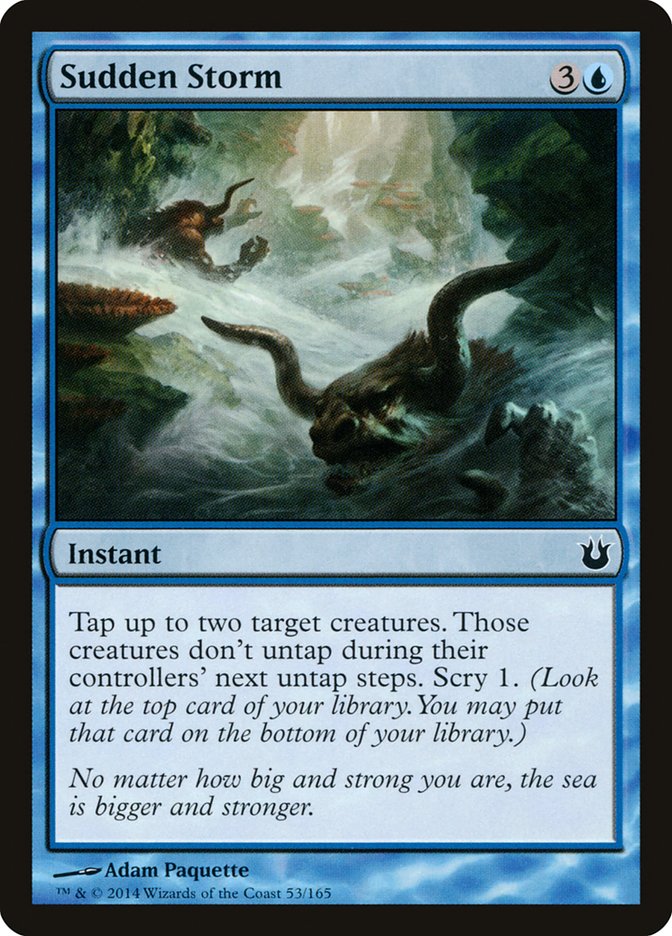
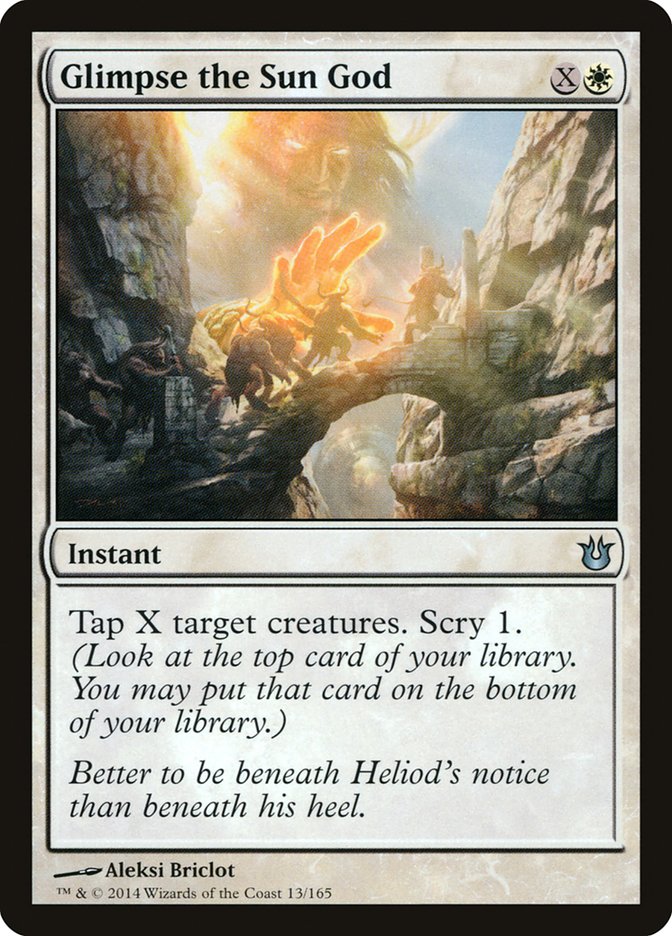
You can actually target your own creatures with these spells for Heroic triggers, which isn’t all that intuitive but can be quite profitable. This matters more for Glimpse, obviously, but I would be lying if I told you that I’ve never used Sudden Storm as a bad/expensive Warrior’s Lesson to trigger a couple of beefy green Heroic creatures to sneak in lethal damage. However, it works really well with Glimpse, as you can use it for value without locking out your creatures. This comes up a fair amount, whether it is announcing attackers, and then using it to “tap” your already-attacking creatures for their triggers while tapping down potential blockers, or on their turn to prevent attacks while snagging an extra trigger or two for your troubles.
Sudden Storm is also a card that works quite well in conjunction with Mnemonic Wall, as the “doesn’t untap” turn off that it grants you allows you to commit a turn to casting Mnemonic the Nummy to get it back in order to buy yourself even more time and get deeper into your deck.
As if all of that weren’t enough, you can also use them to turn on any Inspired creatures you have that can’t get through the old-fashioned way. Again, Glimpse is going to be a lot better for this.
Inspiration Strikes
Besides those tapping spells, there are other ways to manually turn on Inspired, the most obvious of which are Springleaf Drum and Retraction Helix. A bit slow and expensive but quite potent is that tongue-twister of a card, Siren-Song Lyre. While not usually the most desired card, it is quite good against Voltrons. Witches Eye technically turns on Inspired as well, but even I can’t endorse that one, and that’s saying something.
There are also supposedly offensive abilities that you can use on your own army to help with Inspiring your troops. You know, boost morale. Elite Skirmisher is a prime example of this type of trick to get your muse all horizontal-like. Skirmisher is to Glimpse as Wavecrash Triton is to Sudden Storm in regards to tagging your own people.
Leonin Snarecaster is another card that you may not think to target your own creatures with, so look for these opportunities as well. Ephara’s Warden is another card from Theros that is quite good for this. Already bordering just outside the range of playability, there are much higher incentives to play Natalie Portman with the introduction of Inspired creatures. At the very least she’s always been a decent enough sideboard card, and now there is another use for her on such occasions when she does come in off the bench.
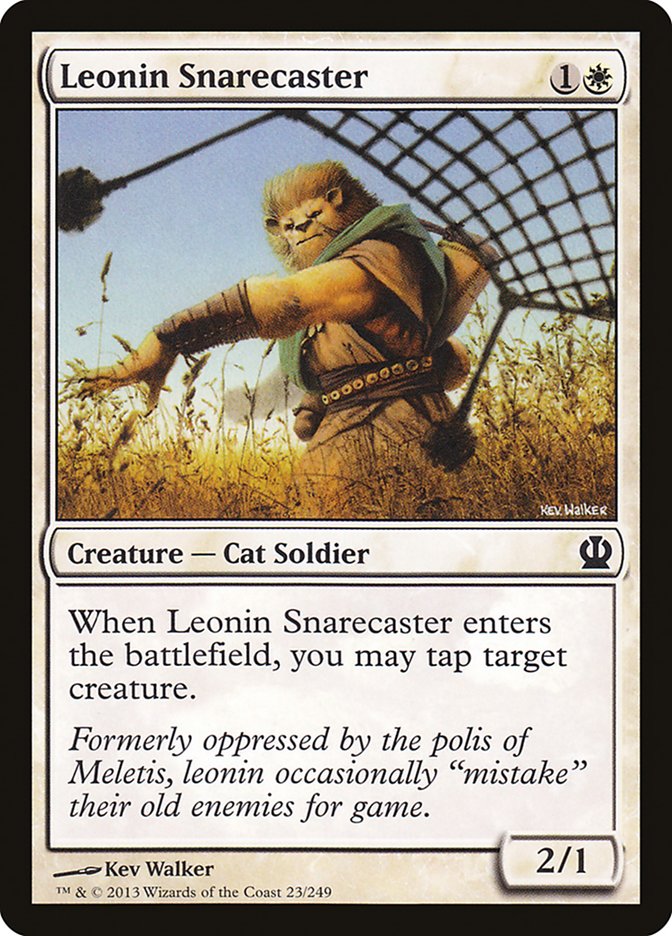
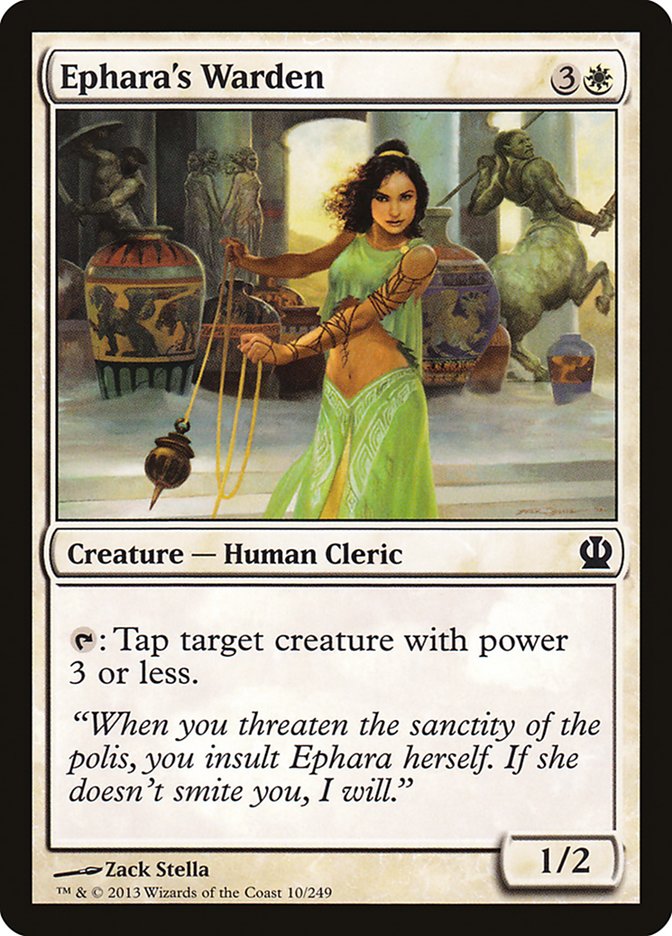
While looking at Theros cards interacting with Inspired creatures, you’ll note that two of the most powerful triggers come tacked onto Aerie Worshippers and God-Favored General, both of which can be a bit finicky to get safely all the way across the battlefield, especially the latter. Some General he is. However, both of the aforementioned are Humans, meaning they can get across with a higher frequency astride a Cavalry Pegasus.
In a similar vein, things like Aqueous Form go up in value when you have one of these creatures that have their powerful triggers balanced by their difficulty to get across. Stratus Walk is a player for this role as well (and is a card that will be discussed at length in a bit).
Untap effects for sudden inspiration are also a thing that we will discuss a little later. As for messing with your opponent’s Inspired creatures, you can actually use untapping effects on their creatures at points where they can’t make use of the trigger, either due to being tapped out on triggers that cost mana, or because you untapped their Kragma Butcher in your own second main phase. More often than not, this will be done by Kiora’s Follower, though it is technically possible to use some of the spells in question. It just isn’t very likely that “countering” an Inspired trigger will be worth the investment of a full card.
Another cool way to interact with Inspired is with Threaten effects. You see, if your opponent has a tapped Inspired creature, you can take it with a Portent of Betrayal or Akroan Conscriptor and you will control the trigger! In addition to getting a little value from that yourself, you can also then choose not to attack with the creature, denying your opponent their own iteration of inspiration.
Giving Threats and Paying Debts
A staple of Limited in the past few years has been the Threaten + Nantuko Husk interaction. And by that, I of course mean Act of Treason + Blood Bairn. I’m old, get off my back (and lawn). In Theros, there was Portent of Betrayal and Tymaret, the Murder King, but at six mana and involving a borderline playable and a mediocre rare, it just didn’t come up all that much. Born of the Gods gives us a few new looks at this interaction, and it’s worth reexamining. As the former Player of the Year and now shamelessly namedropped Owen Turtenwald once said to me of the interaction, “it’s like it breaks all the rules of Magic.” The tempo, the value, the efficiency, the oft-low opportunity cost and the huge payoff all make it something to keep in mind.
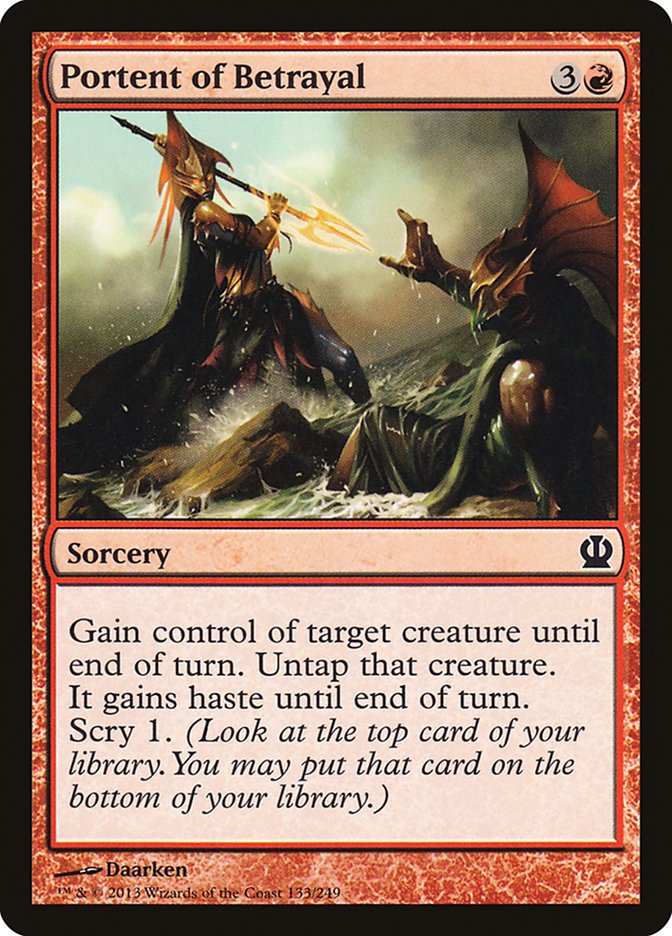
As for sacrifice outlets, we now have Scourge of Skola Vale which (in addition to sounding like a great ski resort) doesn’t cost any mana to sacrifice something, making it much more reasonable to pull off the desired exchange. However, it is another rare (and a more desired one than the King of Murders at that) which greatly narrows one’s opportunities to play with it.
Also at rare, there’s the slightly less wieldy [but way more awesomer] Eater of Hope. You presumably have seven mana if you have the Eater in play, so in addition to being able to just kill something for 3RB with Portent, you can also use the second ability and kill their two best creatures – often getting in an attack, too – all for the price of your worst guy and a Portent! I dare them to have any hope left after that feast.
And just like how you could theoretically use Portent with Rescue from the Underworld if you ever got to nine mana to Mind Control a creature and Zombify another one, you can steal a guy and turn it into a Zombify+ with the mediocre mythic, Champion of Stray Souls.
Akroan Sam Wants You!
All of the above section was considered with a four mana Threaten in mind, but with the shiny new power uncommon Akroan Conscriptor you can steeply cut the cost of that effect as well as have it become repeatable! While it may be hard to get Scourge of Skola Vale and Akroan Conscriptor in the same draft deck (though not unheard of) due to both being strong first picks, it seems like something that could easily happen in Sealed Deck, and would likely be nigh unbeatable if assembled. The potential cheapness of the Conscriptor trigger makes using it alongside sacrifice outlets that do cost mana a much more reasonable proposition.
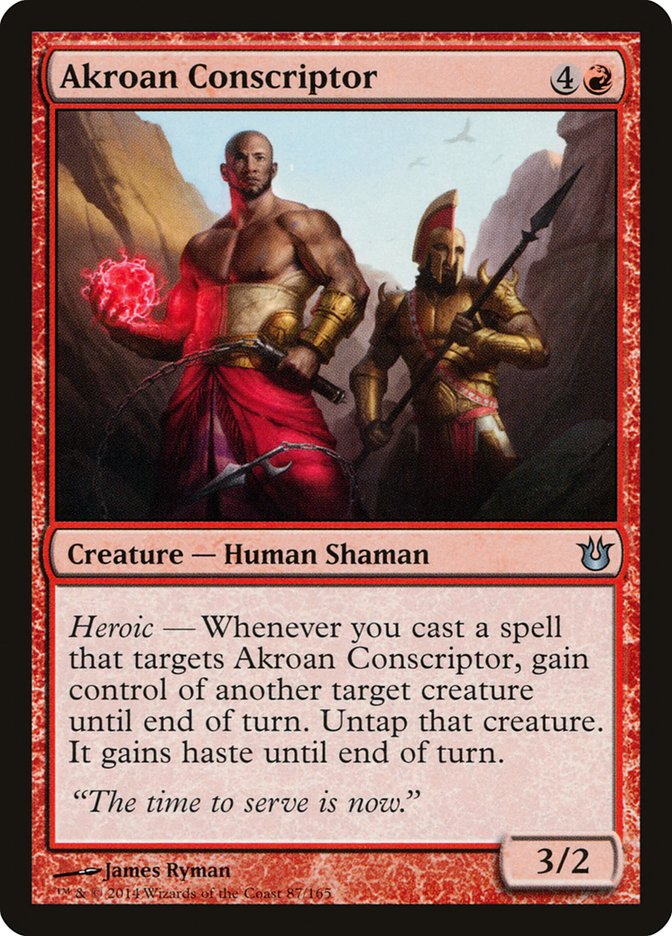
Akroan Conscriptor may seem like a Threaten on a stick, which it is, and with Bestow [almost] always coming at sorcery speed, a good percentage of the time that is precisely what it will be. But the truth is that it can be so much more. Turning any instant spell that targets a creature into a Ray of Command can be devastating. Trading their own creatures for each other is a huge blowout, and chumping their Voltron or fogging their Voltron while eating another guy can both be the kind of race-changer that wins an otherwise losing game. Take this example taken from my stream from a month or so ago and you’ll see the power of getting multiple triggers out of this card. Yes, he got pretty lucky and yes, I could’ve played better, but there’s no denying that he would have lost easily multiple times over had the Conscriptor been any other card.
I’ve already discussed the ability to steal your opponents Inspired triggers with Threaten effects. While all of those uses would certainly make up 99+% of trigger-uses, there are also times where untapping your own creature is more valuable than taking one of your opponents. Whether for a surprise Inspired trigger, ambushing a creature with a big blocker, or messing with Excoriate, these scenarios do come up so be on the lookout for them with this guy in play.
Taaaap and untap. Taaaap and untap.
Speaking of untap effects, these are something that we got some experience with in Theros, but that was just a teaser for the interactions that have been unleashed in Born of the Gods. The main culprit is what I believe to be the top common of the new set, Retraction Helix. It’s already quite profitable to get a Heroic trigger along with your bounce spell (especially considering how good bounce spells are in Voltron-land), but if you add untap effects to that, you can create your own super Sea God’s Revenge for an absolute blowout of a turn.
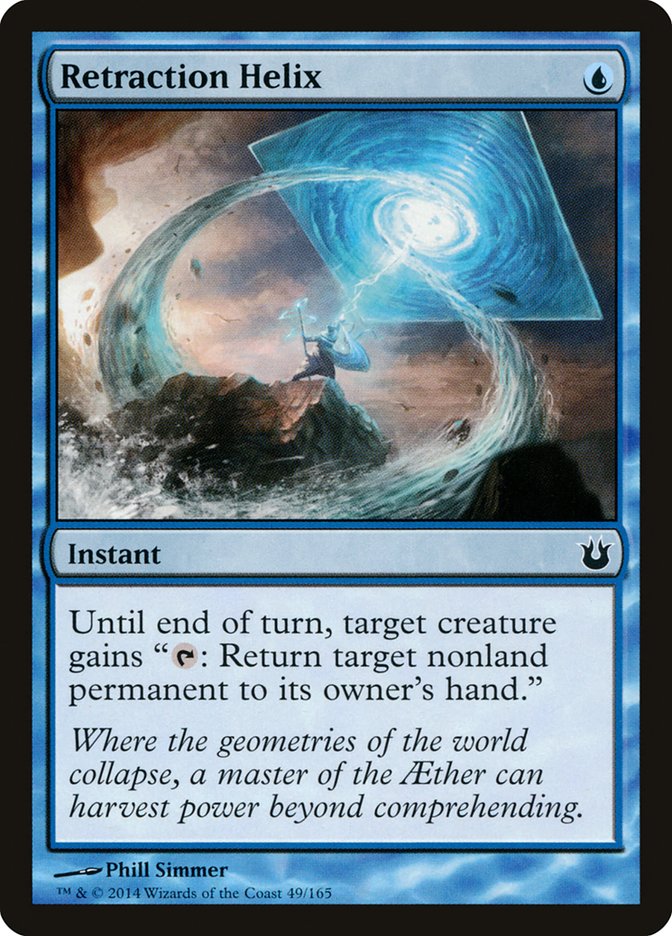
In regards to Helix, Savage Surge and Triton Tactics are joined by Crypsis for cards that are turned into bounce spells with value that really shine when “going off” using a Heroic creature. There is also Kiora’s Follower, which can provide a free untap without costing you a card. Finally, there’s Breaching Hippocamp; a lower-tiered filler card in Theros that has risen to a standing of “decently playable” with the advent of Born of the Gods. Instant-speed surprise Inspired triggers can be quite good, and getting another Retraction Helix activation without having to spend a card (you do get a 3/2) is nice.
Just remember, those are fins, not wings: it has flash, not flying. Hippos don’t fly. Well, Horse Fish don’t at least.
Side Note: Retraction Helix lets your guy bounce a nonland permanent, not just creatures. Not many people realize this, but it does come up: bouncing a Bestow to eat the creature beneath, or delaying an inactive God or weapon, etc.
One card that is pretty sweet with specifically Triton Tactics is Phenax, God of Deception aka Fedex, God of Delivery. You get two more creatures’ worth of milling, plus six, and the ability of the Tactics itself, all for a single mana. Phenax is almost an archetype in and of himself, as once you have it in your pool you can look to snatch up cards with high toughness-to-cost ratios, which not only accelerate your milling once the God is in play but also help defend your position long enough to find and cast it. You can also use Returned Centaur to good effect in this deck, and to a lesser extent Thassa’s Bounty (though I’m not sure how Phenax feels about such cross-worshipping). And just like when I discussed those cards in the Theros article, Phenax’s mill ability can be used to deny the opponent the card selection from scry by binning anything they try to keep on top before they get to draw it.
Another thing that makes the tapped vs untapped status of a creature relevant is the duo of situational removal spells out of the new set: the elite Asphyxiate and its less impressive but still playable counterpart Excoriate. Manipulating these two spells is something that I feel more players should be looking to do. The simplest way to do this is using a tap effect such as Leonin Snarecaster to kill a Vigilant or freshly-cast creature with Excoriate. But there is so much more. You see, the targeted creature needs to still be in the requisite state when the spell goes to resolve. If not? The critter stays.
For example, Savage Surge will save your creature from an Excoriate. The same goes for Asphyxiate: if you tap your creature in response with a Glimpse the Sun God or what-have-you, the removal spell will ultimately be countered.
The “level 3” of this manipulation is using an untap effect on their creature in order to Asphyxiate it. I’ve even bestowed an Observant Alsaid on an opponent’s Agent of Fates to make sure I could Asphyxiate it the next turn because I couldn’t beat it otherwise! There’s also something to be said for playing around Asphyxiate proactively with your non-instant-speed tappers. Against black decks, if you don’t need the creature on defense, tapping it can often be correct if given the option. For example, if you have an important creature that would be untapped (freshly-cast, Vigilant, unable to attack), using your Snarecaster on it for seemingly no reason can give it the necessary room to breathe for at least another turn.
There are a few creatures with tap abilities that can get extra uses out of untaps, but those are hardly lines that are all that difficult to see most of the time. Another good one that I’ve already discussed a bit is to get instant-speed Inspired triggers, which is especially good for combat-oriented triggers.
All Glory to the Hypnotoad
Deepwater Hypnotist is an innocent-looking common from Born of the Gods that is actually a two-drop that often over-performs, allowing multi-turn alpha-strikes through blockers that would otherwise be eating attackers. That being its main function beyond trading itself off early against aggressive decks, Deepwater Hypnotist actually has some cool fringe uses to get that extra value out of your Goblin Piker. There is little more satisfying than when the opponent lines up two blocks and a Savage Surge pushes Hypnotoad over their block while shrinking their other creature, turning a trade into a feast. Its ability is also a particularly good retrick*, mismatching their pump spells. This is particularly good since most tricks deal in +2’s while Hypnotist gives -3. Much like Lost in the Labyrinth from my last Tips and Tricks article, Deepwater Hypnotist is quite effective against deathtouchers.

*A retrick is when they go to play a trick, and you use your own to trump theirs and collect your two-for-one. Or, at the very least, “counter” theirs. There are tricks that are particularly good at retricking, and some that are particularly good at dodging being retricked, and so on.
There are also many things for which power matters, and retricking a Fall of the Hammer or Time to Feed is quite strong. You can also use it in conjunction with Last Breath to choke out a giant duder that would otherwise be difficult to kill. Lastly, you can use it offensively in conjunction with The Showstopper – I mean Natalie Portman – I mean Ephara’s Warden to push through would-be giant blockers. This section isn’t to say we should all be first-picking Hypnotists, just saying that there are often many more layers to a lot of seemingly simple cards than they are given credit for, and that a lot of the more-intricate lines of play involving such cards can often be missed.
Cryptic Crypsis
A lot of this series is about making use of all the parts of the buffalo, and Crypsis I feel is like the intestine… or something. Usually just outside the realm of playability, I think that it deserves a second look a lot of the time and rarely gets one. It is a card that one can pick up late that can do a couple of interesting things. On the surface, it’s an underpowered targeting spell for Heroic purposes. It also untaps your creature, which can have hidden value as discussed in the above section.

It’s also a good card to have in brute-force race situations. When you each have a Voltron hitting back and forth, it can push through a chump block for the finishing blow or get a full chump block yourself at worst. Hold at Bay is another card that is often overlooked but is Ready//Willing to put in overtime. A cheap Heroic instant in a color that cares about such things, it can play Gods Willing in would-be trades as well as against damage-based removal (including Shredding Winds!). It is also a Fog in tight races, and one that can be quite difficult to sniff out. More than one opponent on Magic Online has raged and/or disconnected on me when losing to this puppy. Holding on the Dock at the Bay is one of my more-frequently sideboarded-in cards, mostly against red-based strategies.
Back to Crypsis, it can be a nice sideboard option too, as it does match up well in certain spots. For instance, it does a poor Gods Willing impression for countering things like Keepsake Gorgon triggers. While it may not be the greatest combat trick of all time, it is very difficult to profitably retrick, and can play the role of a retrick itself quite effectively. A common scenario will be that you attack a creature into an inferior creature, they use a pump spell to try to eat yours, and you use Crypsis to save your guy, untapping it to make racing with their inferior creature impossible. Not a full 2-for-1, but certainly a desirable effect in such scenarios.
Lastly, Crypsis does a number on First and Double Strikers, so look to sideboard it in where applicable. Rise to the Challenge and, to a lesser extent, Coordinated Assault are also blown out quite effectively by Crypsis. It also matches up well against deathtouchers.
The Touch of Death
Deathtouch is an interesting ability with some dynamics that are unique to this format, what with the Voltrons and all. I’ve discussed some of the ways that you can exchange profitably with opposing deathtouchers; now I want to talk about how to utilize your own.
Something I forgot to include in my Theros article is that Labyrinth Champion is a card that I’ve used to good effect in conjunction with Baleful Eidolon. Not only do they curve into each other and come with a shock stapled to the combo already, but every subsequent trigger is a Murder.
Gorgon’s Head is a card that can be used for this as well. It’s also quite an effective sideboard card that isn’t boarded in nearly enough. When you’re matching up wimpy white or red creatures (preferably tokens) against beefy green creatures, it can give you a lot of profitable exchanges for a relatively low investment. Just know that if you go to block and they kill the equipment, you’ll be on the receiving end of an unpleasant two-for-one.
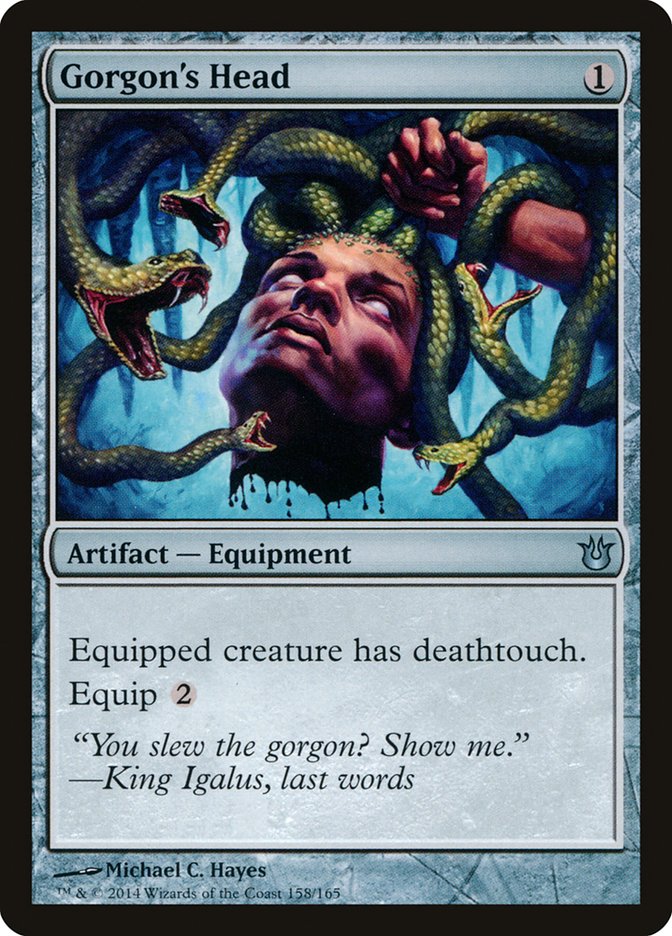
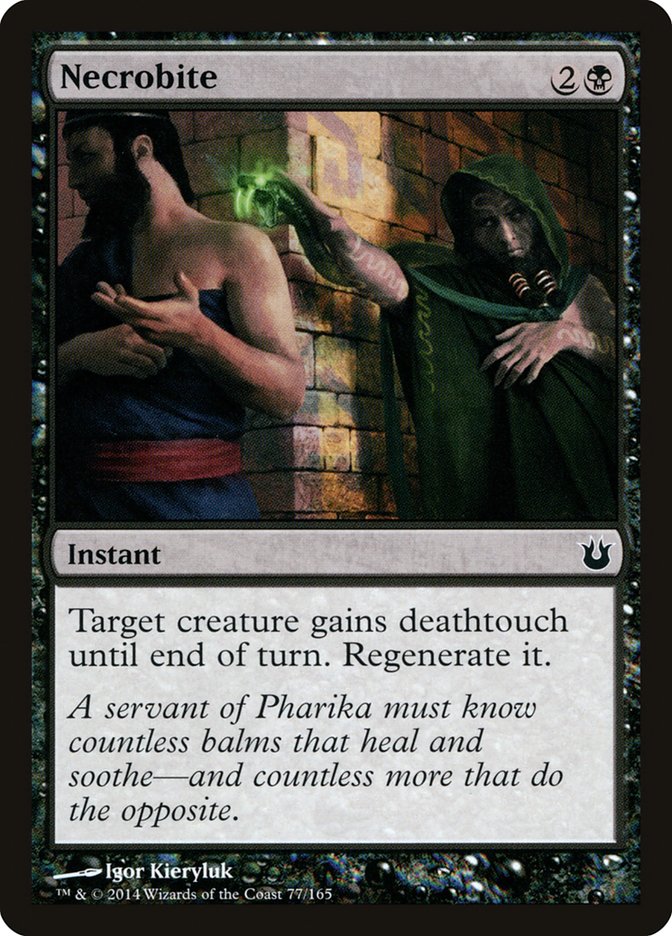
Archetype of Finality also grants deathtouch to your creatures for such purposes. It can also be used to great effect in combination with Lightning Volley to mow down the opposing squad. Since it always wheels, Volley is a card I actively keep track of: if I see one early in pack one, I look to take Archetype of Finality much more highly. The mediocre rare from Theros, Titan of Eternal Flame, also works quite well with things such as Baleful Eidolon, Archetype of Finality, and Gorgon’s Head.
When talking about making the most use out of deathtouch, I would be remiss to not mention its favorable interactions with First Strike and Double Strike as well as Trample. If you have lots of cards with these abilities, consider maindecking your Gorgon’s Head or Necrobite that otherwise wouldn’t make the cut.
While Necrobite may seem like a decently-strong but expensive combat trick, the one-shot of deathtouch can often be worthwhile versus Voltrons and/or in conjunction with the aforementioned abilities. In addition to that, it’s actually an extremely potent retrick – one of the best, in fact. In the Theros edition, I wrote a whole section on Boon of Erebos, and much of that applies to Necrobite as well. One thing I neglected to mention in regards to Boon was how it just so happens to be damn near the greatest response one can have for a Time to Feed. Eat my guy? No no no, eat your guy! Necrobite also matches up hilariously well against the green pseudo-removal spell.
Talk about taking a Bite out of crime.
Luring into a False Sense of Security
Another great use for deathtouch is with Noble Quarry, though you likely need something to pump its power as well to get the full effect. Noble Quarry is an interesting card as it is a fairly unique effect in Theros/Born Limited. There are a couple of cool ways to put the pony to use that I want to go over quickly. The obvious one is to Bestow it on a huge guy (or vice-versa) in order to eat enemy forces.

Alternatively, you can simply use it as bait to get your huge guys through for a big alpha strike. With Bestow, you can put it on a smaller creature and get two alphas through. You can also use regeneration/protection effects such as Necrobite, Boon of Erebos, or Gods Willing to get additional alphas through (often while also generating value). One thing I’ve done before is to use it to get an alpha through, then bounce it post-blockers looking to Bestow it the next turn.
An interaction that costs a bit of mana and isn’t likely to come up until the later game is to use a Fearsome Temper to make the Quarry or the creature it is on big enough to eat smaller creatures while also allowing you to prevent their bigger creatures from feasting on your angry unicorn.
One of my favorite things to do with a Noble Quarry is to put it on a Vortex Elemental and shuffle away their team. This is doubly effective because having a Vortex Elemental makes it more likely that their best creature (minimum) will be on defense for fear of attacking into it in the first place.
Vortex Elemental actually has a lure-esque ability itself, but at five mana for one creature it is fairly ineffective. And generally speaking, an 0/1 isn’t exactly something I’m comfortable leaning too heavily on, what with Spark Jolts, Viper’s Kisses, and Eye Gouges matching up so well against it, especially post-board. However, it does match up quite well against non-flying Voltrons. You can even use it to turn bounce spells into removal spells by activating the first ability, then bouncing your Vortex Elemental. This trick works, as it will use the last known information when the activation goes to resolve, and the blocking/blocked creatures will be shuffled away while good ol’ Vorty is safe in your grip. Speaking of “grip,” another one to look for is when they send their second-best creature into the Vortex trying to protect their best guy while still pressuring you. You then Griptide their champion, block the runner-up and activate, shuffling both away.
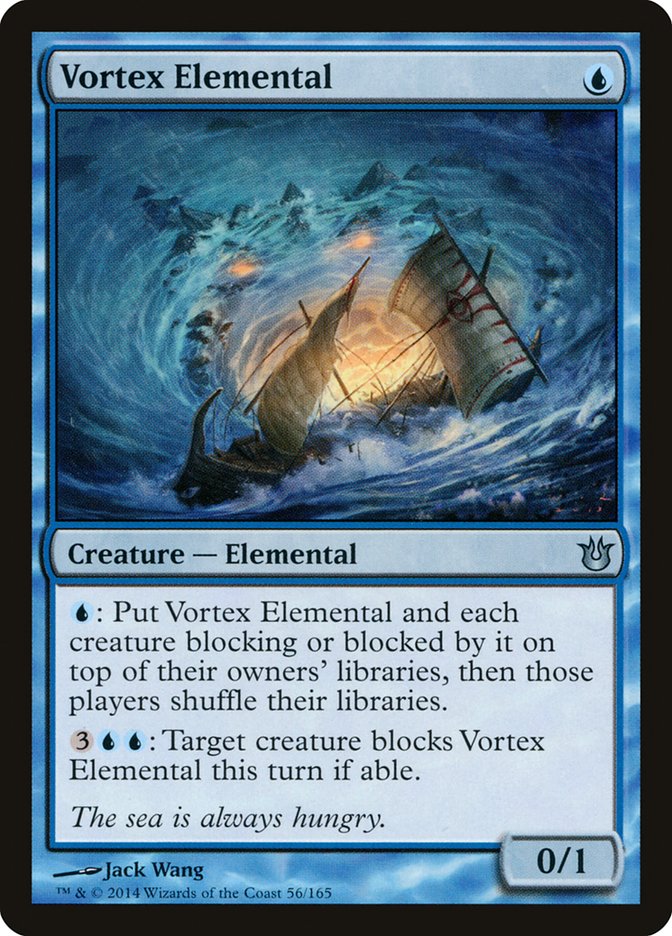
There are also lines where you can turn your Vortex Elemental into a real creature, then use the provoke ability to eat smaller creatures. Any one-drop goes up in value when it means you can get your Ordeals online quickly, but when it also can give you a miniature Abyss that is something to actively seek to do.
One last note on Vortex Elemental is that it doesn’t have to be in combat to activate its shuffle ability, so it can play turtle if the situation calls for it. That is to say, if it would die to a removal spell but you’d prefer it in your library rather than in your graveyard, you can activate it freely in hopes it shows up later on. This can also fizzle the scry on such things as Bolt of Keranos or Rage of Purphoros. There was even a time where I was basically on a one-outer in the late-game, but that one card was at the bottom of my library from an early-game scry whilst looking for lands. So, I used my Vortex Elemental just to shuffle my deck for a chance to hit my game-winning spell. Again, a very corner-case scenario, but something that can happen.
Moonwalking
Stratus Walk is a card that is reasonably efficient on the face of it: a cantripping Heroic enabler that grants a creature evasion at the cost of its ability to block. It goes somewhat late and will generally make the cut, but is rarely given much second thought. However, the card does so much more than it appears. You’re beginning to see a theme in this article, I trust.

Yes, it pairs up well with Floodtide Serpent and Heroic, but it also plays well with Inspired and things like Daxos of Meletis. All of this is simple enough, but what would you say if I told you I targeted my opponent’s creatures with Stratus Walk about a quarter of the time? This is because the “drawback” of the creature being unable to block non-fliers can be used offensively as well. Getting your ground forces through can often be worth giving an opponent’s creature evasion in race situations where you were unlikely to block anyway. It is especially effective if the potential blocker is a wall or something like Vortex Elemental (though we know that they can fizzle the card draw if they know what’s up).
You can also use it in conjunction with anti-flier technology to build your own removal spell. Like clay shooting, you toss it up in the air only to shoot it down. A modern-day Soaring Seacliff + Oran-Rief Recluse. Bow of Nylea and Arbor Colossus are two rares that can pull off this maneuver. I once maindecked a Shredding Winds when I had three copies of Stratus Walk, but more often than not it will be when it comes off the bench and the game develops in a way where this interaction comes up organically. I’ve even used it with Skyreaping to take out an opposing ground creature along with all of their fliers.
Side Note: Skyreaping is possibly the funniest answer to Archetype of Imagination available, as long as you don’t die from the initial alpha-strike it grants. You even get to keep your own would-be fliers!
The End is Nigh
Here we are. Five thousand words on some minutiae of the current Limited format. And I’m sure there is still a lot more to discuss! Let me know how you like this series and if I should continue it with Journey into Nyx. And more importantly, what are some cool interactions or combos that you’ve come across that I didn’t mention? What about wacky archetypes that you’ve seen made work? That is, besides the Chromanticore Challenge, which (while being a true delight) is a bit passe at this point. I’d love to hear the awesome things you guys and gals are doing with 40 cards!
